
| KIT #: | 79735 |
| PRICE: | $7 about 15 years ago |
| DECALS: | One option |
| REVIEWER: | Richard F |
| NOTES: |

| HISTORY |
At the end of World War II the world's remaining air
forces had learned a great many lessons about aircraft design. For cargo planes,
among the most important was the need for a flat cargo deck (ruling out
tail-draggers like the C-47) and easy access cargo doors (meaning front or rear,
as opposed to side doors).
Perhaps the most famous aircraft designed with these issues in mind was the US
C-119 "Flying Boxcar". It first flew in November 1947, building on the twin-boom
and fuselage pod model of the earlier C-82. More than 1,000 were built.
Across the Atlantic, the French faced the same problems with their legacy fleet
of C-47s and Ju52s. In April 1948 the air force ordered two prototypes of the
Nord 2500, which didn't meet the design brief'sspeed requirements. The second
prototype's
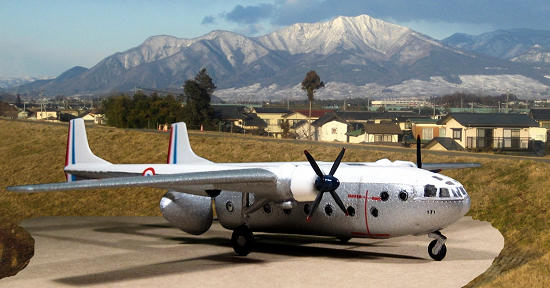 engines
were upgraded andin flight tests this model, the 2501, compared favourably to
the C-82. Production started in 1951 and it was named the Noratlas in 1953.
engines
were upgraded andin flight tests this model, the 2501, compared favourably to
the C-82. Production started in 1951 and it was named the Noratlas in 1953.
In its life, the little Noratlas racked up a range of
experience. A jack of all trades, like the C-119, the Noratlas far exceeded its
original design brief as a humble cargo plane. Israel even reportedly used the
Noratlas as a bomber, though none seem to have been converted to gunships as the
C-119 was. Some were given booster jets, just as the C-119 had in later years.
Unlike the C-119 which did most of its work in Asia, the Noratlas saw most
action in north Africa and the Mediterranean. The French used it to drop
paratroops into Egypt duringthe Suez crisis in 1956 and in Algeria until 1962.
Israel, forced into buying three as part of a deal for 12 Ouragan fighters,
found its reluctance misplaced, because the Noratlas served the IAF well in its
1956, 1967 and 1973 wars. The Israelis used them for maritime surveillance as
well as cargo hauling, and a Noratlas reportedly identified the USS Liberty (a
US intelligence ship attacked, mistakenly or otherwise, by Israeli aircraft).
Further north, Greece used its Noratlas planes to transport troops from Crete to
Cyprus in response to Turkey's invasion of Cyprus in 1974.
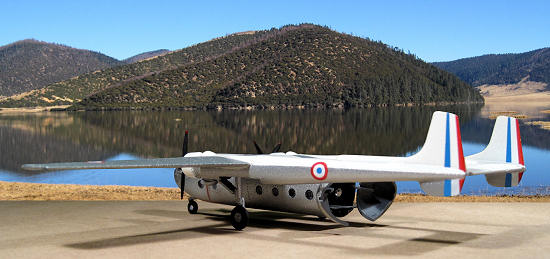 Germany
and France used the Noratlas until the C-160 arrived in the mid-1970s. The
French phased out the electronic warfare version as late as 1989. Some Noratlas
struggled on after that in minor African air forces like Djibouti and Niger but
it is believed only one remains airworthy today (in France).
Germany
and France used the Noratlas until the C-160 arrived in the mid-1970s. The
French phased out the electronic warfare version as late as 1989. Some Noratlas
struggled on after that in minor African air forces like Djibouti and Niger but
it is believed only one remains airworthy today (in France).
In a Cargo Plane Celebrity Smack-down, which aircraft comes out trumps? Decide
for yourself. Here are a few factors to consider, with the Noratlas listed first
and the C-119 in brackets:
Number built: Noratlas: 425 (C-119: 1,183)
Number of military users: 12 (14)
Span x Length: 32.5m x 22m (33.3m x 26.3m)
Total engine power: 4,000 HP (7,000 HP)
Top speed: 405 km/h (450 km/h)
Range: 2,500km (3,670 km)
Weight: 13 tonnes (18 tonnes)
Payload: 8.4 tonnes (4.5 tonnes)
Troops: 45 (62)
Hmmm - hard to declare a winner. For an aircraft roughly the same size, the
C-119 is more than a third as heavy again as the Noratlas. In everything but
payload the C-119 wins on performance, but payload haulage is the cargo plane's
bread-and-butter.
| THE KIT |
This kit is obviously a very simple build and you'd think
there wouldn't be much to say about it. You'd be right. It is made from a soft
grey plastic, generally cleanly moulded but with massively over-sized rivet
detail. The cockpit transparency is clear enough
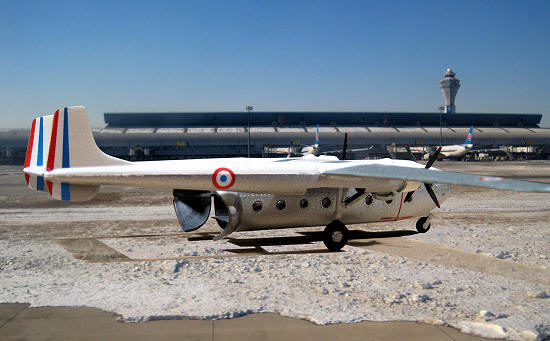 but the
fuselage windows, while quite thin, are hugely thick in this scale. No-one would
try to pretend that this kit was designed to be a high-fidelity replica, though,
so for what it is, it is quite good. The undercarriage is also obviously a bit
over-scale but for all that it doesn't look too bad, because pictures show that
the nose gear, in particular, is pretty chunky on the real thing.
but the
fuselage windows, while quite thin, are hugely thick in this scale. No-one would
try to pretend that this kit was designed to be a high-fidelity replica, though,
so for what it is, it is quite good. The undercarriage is also obviously a bit
over-scale but for all that it doesn't look too bad, because pictures show that
the nose gear, in particular, is pretty chunky on the real thing.
Forgive me a quick beef about the scale, though. 1/170? It really is a
non-scale. Typically, small aircraft are either 1/144 or 1/200. According to
wikipedia, N-gauge model trains are somewhere between 1/148 and 1/160 depending
on the brand. So where does 1/170 fit in?
The Noratlas' wingspan is 32.5 meters. In 1/144 that's 22.5 cm; in 1/160 (N
gauge) it's 20.3 cm, in 1/170 it's 19.1 cm and in 1/200 it's 16.2cm. So, next to
an N-gauge train the model might be fine, but next to 1/144 planes it's 3 cm too
narrow and next to 1/200 planes it's 3 cm too wide.
Still, let's face it. This little kit is one you build strictly for the fun and
for the novelty of this unusual type. With that in mind, it doesn't look too
unusual sitting next to its compatriots in any similar scale, though to my eye,
it's more realistic displayed with 1/144 models than 1/200 models.
| CONSTRUCTION |
There's very little that's difficult in building this kit.
I decided to try out my scratch-building skills - for the first time - and open
the clamshell cargo doors at the back of the fuselage pod. Before doing any
construction, I lined up the two fuselage halves, marked a suitable-looking
point, and then cut the doors off.
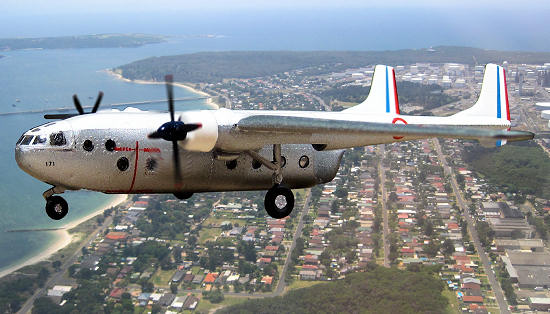 Next
was the quick task of measuring up a suitable cabin floor from white plasticard,
cutting it out and installing it on one fuselage half. I painted the whole
interior (both sides) a dark colour and then masked each cabin window before
installing them. Some nose weight was added and then I joined the fuselage.
Next
was the quick task of measuring up a suitable cabin floor from white plasticard,
cutting it out and installing it on one fuselage half. I painted the whole
interior (both sides) a dark colour and then masked each cabin window before
installing them. Some nose weight was added and then I joined the fuselage.
The wings and tailplane went together without any grief. Take care to get the
tailplane parallel to the ground. The main wheels slot into the tailbooms and
the engines and propellers join easily enough to the front of the booms. There's
no detail in any of the wheel wells but I didn't bother masking these areas off.
After painting the whole aircraft (see below) I found some scrap plastic to
build the door hinges. I'd hoped for something less industrial-sized and
slightly more scale-sympathetic, but I wasn't able to get suitable strength in
anything smaller than what I ended up using (parts of the sprue from a different
kit). After making some basic jigs to hold it all together while the glue dried,
I committed to installing the doors. A few tries later on each one and they held
long enough in the correct position for the glue to hold them in place
permanently. They are still quite fragile but are well-protected from bumps by
the booms and the tail.
In contrast to my usual practice of free-handing the canopy framework, I masked
it this time (and never again!).
| COLORS & MARKINGS |
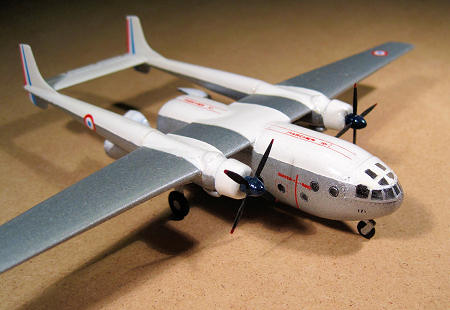 The kit
includes generic decals for a French air force Noratlas. Having misplaced the
instructions I followed the box art, giving the aircraft aluminium wings and
lower fuselage, and white upper surfaces. Sadly the box art shows a front view,
so I couldn't see what the aircraft looks like from above. I think I probably
should have painted the entire central wing section white, rather than simply
selecting white for the fuselage and booms.
The kit
includes generic decals for a French air force Noratlas. Having misplaced the
instructions I followed the box art, giving the aircraft aluminium wings and
lower fuselage, and white upper surfaces. Sadly the box art shows a front view,
so I couldn't see what the aircraft looks like from above. I think I probably
should have painted the entire central wing section white, rather than simply
selecting white for the fuselage and booms.
Normally on something so small I would have brush painted the main colours, but
this time I used Testors spray cans (gloss white and aluminium).
Writing this, I have also noticed I left out the black leading edges on the
wings. Grrr! Ah well, next time!
Decals were a breeze, especially on the glossy white surface. There are so few
that it took no more than ten minutes to finish them.
| CONCLUSIONS |
A fun kit. Hang your accuracy and fidelity concerns at the door and just enjoy it. It was a simple conversion - my first ever - and because it is small and inexpensive, it was a good kit to try that on. If you didn't build the doors in the open position, then this one is truly a one-day wonder, good for a quick and unusual addition to your shelf's air base.
| REFERENCES |
I didn't use any when I actually built the kit over a
decade ago but here are some handy links with lots of photos:
http://www.oldprops.ukhome.net/Noratlas.htm
http://www.vectorsite.net/avnorat.html
March 2010
Copyright ModelingMadness.com. All rights reserved. No reproduction in part or in whole without express permission from the editor. If you would like your product reviewed fairly and quickly, please
contact
the editor or see other details in the
Note to
Contributors.
Back to the Review Index Page 2024